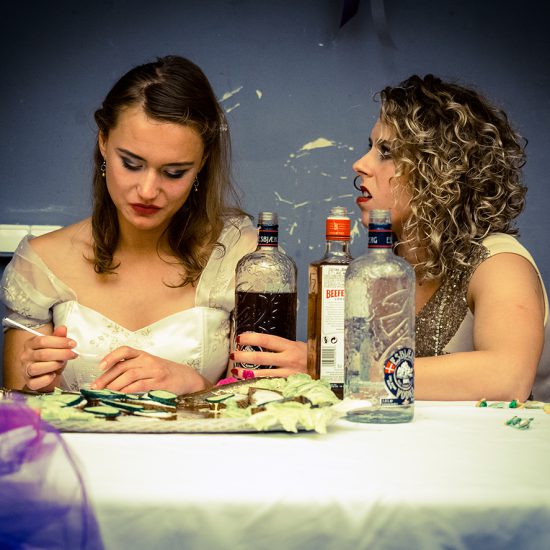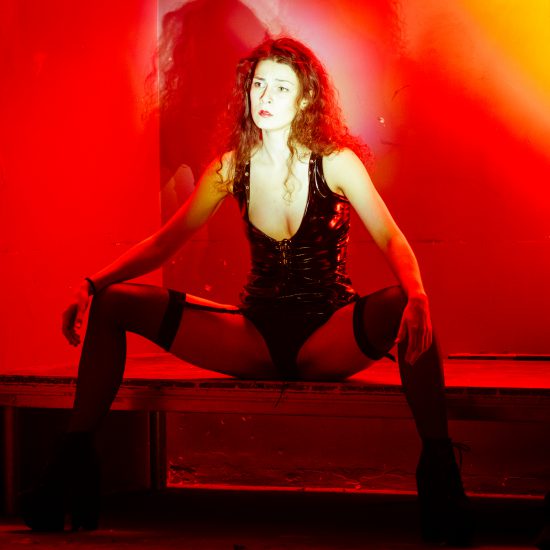The Captive Mind (Miranda)
In the 15th Gdansk Shakespeare Festival Oskaras Koršunovas of Lithuania presented his latest work – Miranda. This performance is not only an original adaptation of Shakespeare’s The Tempest, but also perhaps the most interesting interpretation of this work that I have ever seen. It was, by all means, one of the best performances of the festival.
In the play, the island Prospero and Miranda end up on is a small apartment, a place of exile of an intellectual from the Eastern bloc. In the place – stacks of books, comfortable armchairs for reading, a nice plant… Koršunovas says that it was the “system” that condemned Prospero to solitude and inner emigration. The apartment is a hypothetical island. The view of the island will soon begin to change like in a distorted mirror: the theatrical stage box seems to be cut out of space: the invisible walls are wrapped in darkness and emptiness. We don’t just see what is happening on the island, but also become aware of the fact that there is nothing beyond it, as if it were floating in a black hole.
There are only two characters in the performance – Prospero and Miranda. The old, ailing man takes care of his handicapped daughter (she has problems speaking, is unable to walk and eat on her own). In his interview published in Gazeta Wyborcza, Koršunovas said that Miranda may even be Prospero’s soul. Yes and no (it is the polysemy of the performance that determines Miranda’s many-sidedness). The girl is absolutely dependent on her father, but her obvious dependence will change throughout the performance. Miranda makes her father read The Tempest to her over and over again (in the beginning the idea even seems infantile). However, soon a kind of dramatization begins and the boundaries between reality and imagination slowly and gradually fade. The props, the lighting, the set design, the costumes, and various details are used very cleverly in Miranda; they modify the mood of the play, its dynamics, and the characters’ age. The relationship between the man and the woman, their personalities and bodies will soon change. In the dream she will become Ariel who demands freedom. Moreover, she will regain strength, begin to walk, articulate, even shout, and will even start dominating and controlling the old man. But he too will soon shed his skin and transform into the half-naked, lewd, and primitive Caliban, who will harass and terrorize the awakened Miranda. Or maybe Ariel? All those aspects of femininity and masculinity alternate in the play and are closely related. The body, which is a cage for Miranda’s soul seems to be a blessing to Prospero, who wants to have it only for himself. Maybe that’s why Miranda tries to break free from her creator’s control once she becomes Ariel?
But the man in turn transforms into the foppish Ferdinand and now the disabled girl is ready to give him everything. So, what is that other person like? How much can they be changed by feelings, time, and alcohol (Prospero drinks a lot, which gives the audience a chance to see in him a couple of other characters of The Tempest – the comic and immoral Stephano and Trinculo). <…>
The core motif of Miranda is the swan dance from Tchaikovsky’s ballet Swan Lake and the choreography of The Dying Swan created especially for Maya Plisetskaya. Even before the performance begins, from the TV set standing on the stage, we see scenes from Swan Lake’s finale – perhaps it is the moment of the princess’ liberation (in the moment of death she is freed from the body that she hates). Miranda’s body is also her prison – when she wakes up, she stretches her arms like a ballerina, resembling the white ballerina figurine standing on the cupboard behind her back. Her body is sick, it contrasts with her stormy inner life; it steals Ferdinand’s freedom and feelings. Hence her similarity with the White Swan. However, she is also the Black Swan, the White Swan’s double on the way to her destruction, just as predatory as the double of Miranda – Ariel. The soul, the spirit, which will help her break free at the very end of the play dancing the dance of the dying swan as flashes of light alternate with darkness.
This performance has made such a strong impression on me because it is full of moments of dramatic tension: sometimes the story is lyrical, sometimes tragic, and sometimes even comical (when the sinister fog appears and scares Miranda to death, but is in fact only the result of Prospero burning the soup in the kitchen). Despite these “deviations” the play is very close to the spirit of The Tempest. After the performance, somebody made a very good point that this is an exemplary interpretation of a dramatic text. In technical terms, Miranda is indeed perfect. <…>
It is hard to say everything I want to say about Miranda because the play is so multifaceted, which, in my opinion, is the predominant feature of a perfect work of art, because it makes you want to go deeper and deeper into it. But I know that there will always remain the intangible, elusive and bewildering mystery – the proof of art’s existence.



